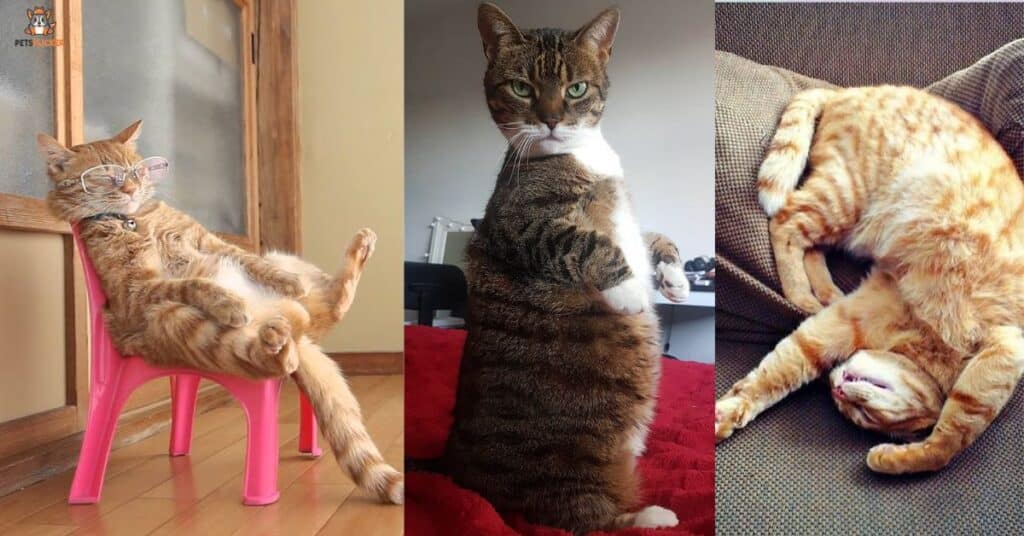Cat sitting positions refer to the various ways cats sit or lounge, which can indicate their mood, comfort level, and overall well-being. Observing these positions helps cat owners understand their feline companions’ emotions and needs more effectively.
Ever wondered what your cat’s sitting positions really mean? From the classic loaf to the acrobatic sprawl, each pose tells a tale of feline emotions. Unlock the secret language of your kitty’s lounging style and deepen your bond with your furry friend. Dive into the world of cat sitting positions and decode their hidden messages today.
Understanding cat sitting positions is like deciphering a silent language. Each posture, from the relaxed loaf to the alert sphinx, offers clues about your cat’s mood and comfort. By observing these positions closely, cat owners can decode their furry companion’s feelings and strengthen their bond.
The Language of Cat Sitting Positions and Body Posture
Cat sitting positions and body posture play a crucial role in understanding a feline’s emotions and intentions. Observing these subtle cues can provide valuable insights into a cat’s mood and well-being.

- Posture Interpretation: Scrunching up into a ball or crouching low may indicate anxiety or pain, while stretching out signals a lack of perceived threat. Paying attention to body orientation helps decipher what captures a cat’s interest.
- Contextual Consideration: Individual cat personalities and environmental factors greatly influence posture interpretation. For instance, a cat lying on its back with an exposed belly might not always be an invitation for a belly rub; it could indicate defensive readiness.
- Common Poses: Familiarizing oneself with common cat poses such as the loaf, sphinx, belly-up, and crouching positions aids in understanding a cat’s emotional state. Each pose carries its own meaning and context.
- Bond Strengthening: By attentively observing and interpreting cat sitting positions and body language, owners can deepen their bond with their feline companions, leading to a harmonious living environment for both parties.
Reading the Room: Understanding Cat Sitting Positions in Context
Assessing cat sitting positions in context involves considering various factors such as the environment, the cat’s behavior, and the overall ambiance. For example, a cat sitting in a relaxed loaf position while purring and kneading in a quiet and familiar setting likely indicates contentment and relaxation.
If the same cat is crouched low with wide eyes and dilated pupils due to loud noises or unfamiliar stimuli, it may suggest fear or anxiety. By noting these contextual cues, cat owners can gain valuable insights into their cat’s emotional state and respond appropriately to ensure their well-being.
Identifying Comfort Zones: Safe Spaces and Cat Sitting Arrangements
Creating comfortable spaces for cats involves considering their preferred sitting arrangements and providing safe environments. This includes offering elevated perches, cozy beds, and quiet corners where cats can relax and feel secure.
Understanding and accommodating these comfort zones can foster a sense of contentment and well-being for our feline companions.
The Tell-Tale Tail: High Tails and Confidence
A cat’s tail position can reveal a lot about their mood and confidence level. When a cat holds its tail high, either straight up or slightly curved, it often indicates a sense of confidence and comfort in its surroundings. This high tail posture can be observed when a cat is exploring, playing, or interacting positively with their human or fellow felines.
Travel Stress and Cat Carrier Body Language
Travel stress in cats can be evident through their body language, especially when they are placed in a cat carrier. Signs of travel stress can include flattened ears, dilated pupils, restlessness, vocalizations, or attempts to escape the carrier.
It’s important for cat owners to observe and understand their cat’s body language during travel to ensure their comfort and well-being.
Body Language: Understanding Cues

Understanding a cat’s body language cues is essential for interpreting their emotions accurately. By observing their posture, gestures, and expressions, you can gain valuable insights into your cat’s mood and well-being, fostering a deeper bond and effective communication.
- Posture and gestures convey emotions and intentions.
- Facial expressions, ear positions, and tail movements are key indicators.
- Recognizing stress signals helps provide appropriate care.
- Building trust through attentive observation enhances the human-cat relationship.
- Creating a calm and safe environment encourages positive body language.
- Regular interaction and observation improve your understanding of your cat’s cues.
Cat Sitting Positions and What They Mean: The Loaf and Beyond
Cat sitting positions can reveal a lot about a cat’s emotions and comfort level. One common position is the “Loaf,” where a cat sits with its paws and tail tucked beneath its body, indicating contentment or readiness for anything. This posture is often seen when a cat feels safe and secure in its environment.
Beyond the loaf position, cats may also exhibit other sitting poses with distinct meanings. For example, the belly-up position, where a cat lies on its back with the belly exposed, can signify trust and relaxation, although it may also indicate readiness for defense in certain situations.
Understanding these sitting positions helps cat owners interpret their feline companion’s emotions and needs more effectively.
Paws Under Body: The Loaf Position Decoded
The “Loaf” position is a common sitting posture observed in cats, where they tuck their paws and tail beneath their body.

This position is often seen when cats are feeling content, relaxed, and comfortable in their surroundings. It’s a sign of their trust and sense of security, indicating that they feel safe enough to lower their guard and assume a relaxed posture.
The Belly Up Pose: Relaxation or Readiness?
The “Belly Up” pose in cats is commonly associated with feelings of relaxation and trust. When a cat exposes its belly, it’s a sign that they feel comfortable and secure in their environment. This posture can often be seen during moments of calmness and contentment, especially when the cat is lounging or enjoying a nap.
It’s important to note that the “Belly Up” position can also indicate readiness for defense. In certain situations, such as when the cat feels threatened or uncertain, they may assume this posture as a defensive mechanism. This can serve as a warning sign for owners to approach with caution and be mindful of the cat’s emotional state.
Related Content: Can A Serval Cat Kill A Human? Expert Explain
Unveiling Different Cat Sitting Positions for Comprehensive Insight
Understanding different cat sitting positions is crucial for gaining comprehensive insight into a cat’s emotional state and well-being. Here are some points to consider:
- Various sitting positions: Cats exhibit a range of sitting poses, each with its own unique meaning and indication of the cat’s mood.
- Emotional cues: Observing your cat’s sitting positions can help you decipher their emotions, whether they are relaxed, anxious, playful, or defensive.
- Strengthening the bond: By understanding and responding to your cat’s sitting behavior, you can build a stronger bond and create a more harmonious relationship with your feline companion.
The Complex Dynamics of Cat Sitting Poses and Human Interactions
| Cat Sitting Position | Possible Meaning |
|---|---|
| Loaf | Content or prepared for potential threats |
| Curled-Up | Anxious or in pain |
| Belly-Up | Relaxed and showing trust, but potentially defensive |
| Arched Back | Fearful or aggressive |
Understanding cat sitting poses and their dynamics in human interactions is key to building a strong bond. Observing their posture helps interpret their mood, fostering better communication and mutual understanding. By responding appropriately to their cues, we can create a harmonious environment for a thriving relationship.
Other subtle cues such as tail position, ear movement, and vocalizations can enhance our understanding of a cat’s emotions and intentions. Building a strong bond with cats involves respecting their boundaries, responding sensitively to their signals, and creating a safe and enriching environment where they can express themselves comfortably.
Analyzing Common Cat Sitting Positions to Gauge Mood
Analyzing common cat sitting positions can give us clues about their mood and feelings. For example, when a cat sits in a loaf position with its paws tucked under, it’s usually content and relaxed. On the other hand, a cat curled up into a ball might be feeling anxious or in pain.

When a cat exposes its belly while sitting, it could mean they feel relaxed and trusting, but it’s important to approach gently as they might also be defensive. Lastly, an arched back often indicates fear or aggression, so it’s best to give the cat space and avoid confrontational actions. Understanding these positions helps us communicate better and build a stronger bond with our feline friends.
Recognizing Signs of Stress in Cat Sitting Techniques
Recognizing stress in cat sitting involves noting behaviors like excessive grooming or hiding, alongside changes in posture such as constant curling or defensive stances. Providing a calm environment can help alleviate stress and improve a cat’s well-being.
Assessing Happiness Through Relaxed Cat Sitting Postures
Assessing a cat’s happiness through relaxed sitting postures involves observing signs such as a loosely curled-up position, a relaxed tail, and ears in a natural position. Contented purring and friendly interactions further indicate a happy feline demeanor. Understanding these relaxed postures helps ensure a comfortable and joyful environment for cats.
Related Content: Snow Bengal Cat: Everything You Need To Know
Frequently Asked Questions
What are some common cat sitting positions and their meanings?
Common positions include the loaf (content or alertness), belly-up (relaxed or defensive), curled-up (anxious or comfortable), and arched back (fearful or aggressive).
How can understanding cat sitting positions strengthen the bond between cat owners and their feline companions?
Understanding these positions helps owners interpret their cats’ emotions accurately, fostering trust and effective communication, leading to a stronger bond.
What role does context play in interpreting cat sitting behavior?
Context, including individual cat personalities and environmental factors, greatly influences the interpretation of cat sitting positions, avoiding misinterpretation.
How can cat owners create a harmonious environment based on cat sitting positions?
By responding sensitively to their cats’ cues and providing a safe and enriching environment, owners can create a harmonious environment for a thriving relationship.
What are some signs of stress in cat sitting techniques?
Signs include excessive grooming, hiding, changes in posture like constant curling or defensive stances, indicating anxiety or discomfort.
How can cat owners assess their cat’s happiness through relaxed sitting postures?
Observing signs like loosely curled-up positions, relaxed tails, and natural ear positions, along with contented purring, indicates a happy feline demeanor.
What are some tips for identifying a cat’s comfort zones based on sitting arrangements?
Providing elevated perches, cozy beds, and quiet corners can create comfortable spaces, fostering contentment and well-being.
How does a cat’s tail position convey their mood and confidence level?
A high tail indicates confidence and comfort, while a low, tucked tail may signify anxiety or fear.
Conclusion
Understanding cat sitting positions and decoding their meanings is essential for cat owners to effectively communicate with their feline friends. Cats use various sitting postures like the loaf, belly-up, and arched back to express their emotions and comfort levels. For instance, a cat sitting in a loaf position with relaxed body language often indicates contentment, while an arched back may suggest fear or aggression.
Contextual factors such as the cat’s personality and environment also play a significant role in interpreting sitting positions accurately. It’s important for owners to observe these postures in different situations to avoid misinterpretation. By paying attention to these cues and responding appropriately, cat owners can strengthen their bond with their cats and create a harmonious living environment where both parties feel understood and cared for.

Elax is a seasoned writer with five years of experience specializing in articles focused on pets. His passion for animals and extensive knowledge shines through his engaging and informative writing style, captivating readers with insights into pet care and companionship. With a knack for crafting compelling content, Elax brings a wealth of expertise to the realm of pet-centric literature on your website.







